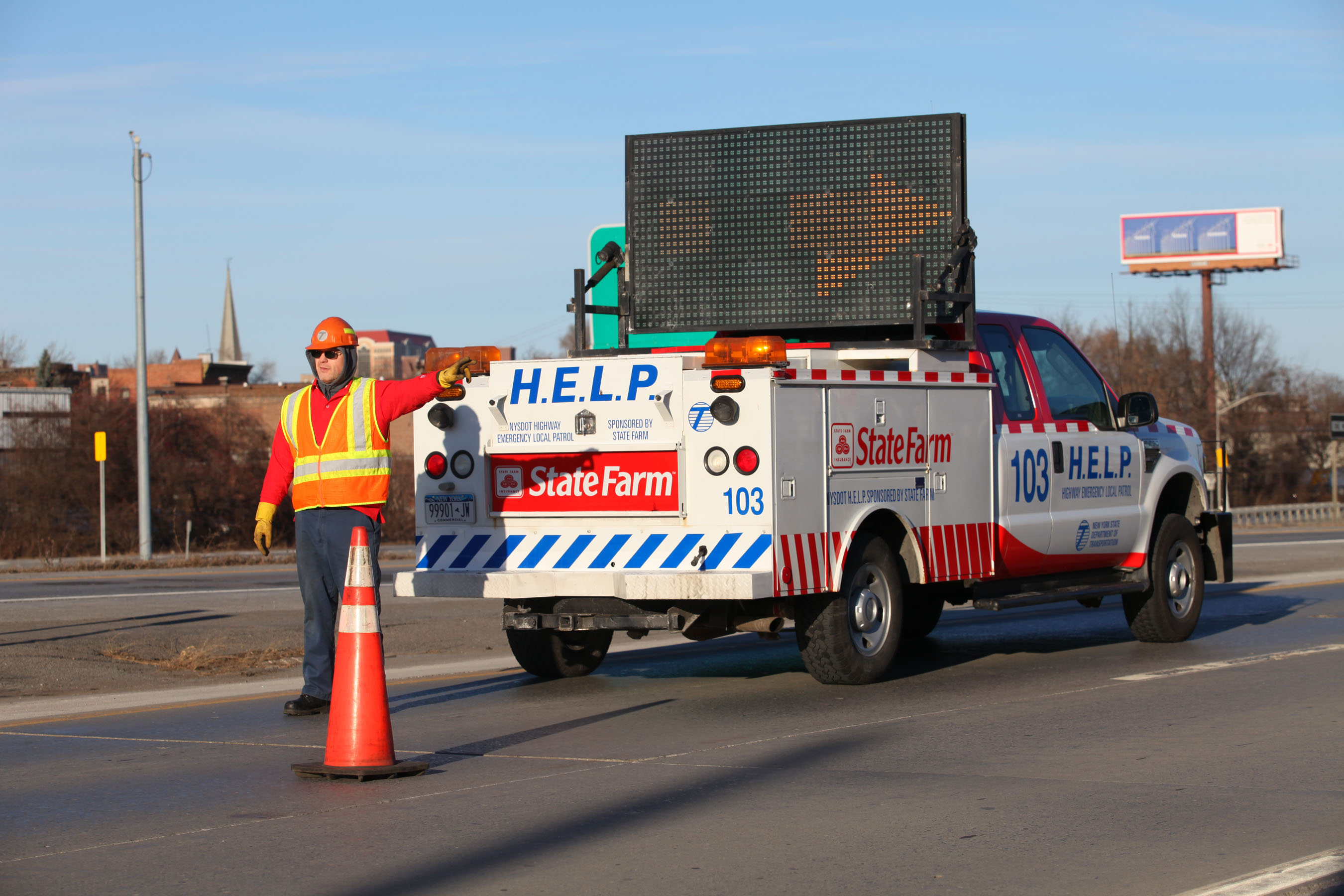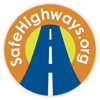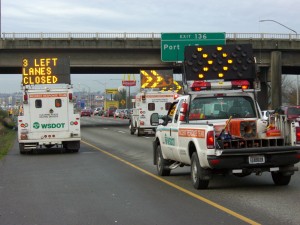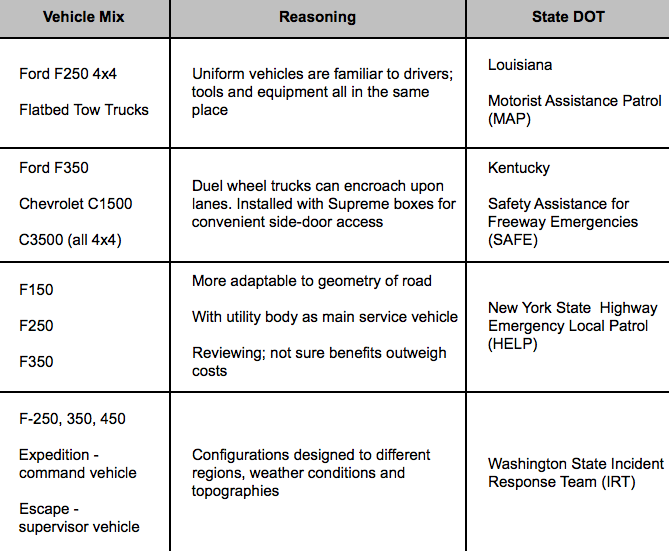Wading through the Options
Some Best Practices for Selecting Vehicles and Equipment
By Leo Rickertsen
Safety Service Patrols (SSPs) are like fingerprints: no two are exactly alike. This is apparent in the variety of equipment and vehicles they select. What’s the “right” vehicle and equipment combination? The short answer is, it depends.
It Depends on the Territory
“Washington runs the gamut from high desert to mountain passes to ocean shore,” said Vince Fairhurst, WS DOT State Incident Response Program Manager, “so we have different vehicles and configurations for different topographies.” Some Washington State vehicles, for example, have canopies to keep equipment covered so it won’t get wet and freeze. Other vehicles have an open bed for faster access.
Patrols generally prefer four-wheel-drive Ford F250 and F350 or Chevrolet C1500 trucks. Where maneuverability and lane width is a premium, they may use F150s or similar half-tons. And for heavy-duty requirements they may add F450 or C3500 trucks, perhaps including a flatbed tow. Fleets may also include sport utility and cross-over vehicles for supervisors.
From the driver’s point of view, Robert Vidrine, Baton Rouge Supervisor for Louisiana DOT’s Motorist Assistance Patrol (MAP) likes it that trucks have storage bins, “less noise from the tools and keeps them clean,” and are 4×4 configured “for extreme situations like when something has run off into the brush.”
His state-wide supervisor, Corey Rhodes, also prefers that the vehicles are all the same, “so drivers can use any vehicle; tools and equipment are all in the same place.”
It Depends on the Purpose
SSP programs geared to narrowly assist motorists may have quite different vehicles and equipment from those designated for more serious traffic incident response. Some vehicles are prepared to push, pull or drag anything, even a rolled-over semi, to get it to the shoulder. Others are first responders equipped with emergency lights and siren and police department-dispatched for emergency incident management.
Rebecca Gibson, PE, NYSDOT HELP said, “as long as the equipment necessary to perform the duties of the SSP are there and as long as the vehicle meets those specifications, that’s what matters.”
“We used to have full-sized vans,” said Incident Management Division Administrative Section Supervisor Jay Postlewaite of the Kentucky Transportation Cabinet (KYTC), “but we now have four-door cabs instead of vans with one extra seat, so we can easily take four people at once to safety from a disabled vehicle.”
It Depends on Resources
Some states start with a standard vehicle and add specialized equipment such as push bumpers, flare drops, communications, VMS (variable message sign) or arrow boards and emergency lighting. Others specify a cab and chassis outfitted with an aftermarket—or even custom-designed and built—utility box to hold inventoried equipment and tools.
Tool lists can expand and vary as needs and budgets allow. Current programs typically have jacks, air compressor or rechargeable impact wrenches, socket sets and other hand tools, one-gallon gas containers and pump-off diesel, radiator fluid, jump-start systems or jumper cables, oil dry, brooms, chainsaws, hacksaws, pry bars and perhaps gas-powered leaf blowers (to remove glass). They may have tow lines (although some found that drivers were not comfortable using power winches), spot lights, and specific capabilities to remove rounded lugs or loosen rusted ones.

Kentucky SAFE vehicles include special compartments for tools and equipment as well as a VMS on top of the box truck and an extra seat.
Equipment placement on the truck is also considered important. “We position it to help keep the driver out of traffic,” said Rebecca Gibson. “For example we have air-compressor and battery-jack connections on both the front and the back so the vehicle can pull in front or behind, whichever’s safer.”
New York City DOT maintains patrol or police officers within its SSP team. This trained-officer presence improves on-scene capabilities, enhances communication and cooperation among responding groups, and even adds assurance to stranded motorists when they see a recognizable vehicle and trusted uniform pulling in behind them.
Communication equipment can vary from simple radios and cell phones to PA systems, GPS, onboard PC and AVL (automated vehicle locator) integrated with state tracking and live streaming video. The options are only limited by budgets and desired capabilities (see Technology Enhances Safety article for more information).
It Never Compromises Safety

NYSDOT encourages its HELP drivers to use VMS to alert motorists of an upcoming lane closure or of debris in the roadway.
There is no dispute among agencies that the safety of responders, stranded individuals, and driving traffic is paramount. “We like to see HELP trucks using their VMS to alert drivers for a lane closed ahead or for debris, “said Rebecca Gibson. “It’s safer and more situational than just turning on lights.”
Generally, standard items such as response vehicle lighting, onboard VMS and arrow signs, orange traffic cones, flares (including LED), and portable roll-up signs may be augmented by a range of hardware such as AEDs (automated external defibrillators) for CPR (cardio-pulmonary resuscitation), sonar on bumpers to avoid backing-up collisions, or even light-weight racing jacks.
We’re looking to add ramps to use on tandem axle trailers to change flats. Makes it easy to pull a loaded stock trailer so the axle with the good tire is up on the ramp, and change the flat, “said Jay Postlewaite of the KYTC, “Much better than jacking it up.”
Safety Service Patrols may be as different as fingerprints. But they share a common grasp in the goal to minimize the congestion caused by incidents and to keep everyone safe. “Our ultimate goal is to remove any hazard in the safest, most expeditious way and reduce a dangerous situation,” said Jay Postlewaite.
“This is the best program that we do,” said KYTC ITS Project Management Engineer Elizabeth Delaney. “People love it.”
Additional Information
See our Equipment Section on our Resources page
Watch our video of a tour of the equipment used by INDOT Hoosier Helpers


